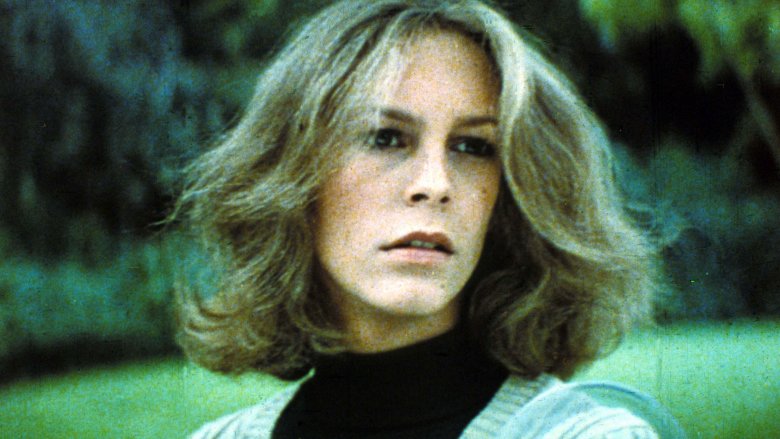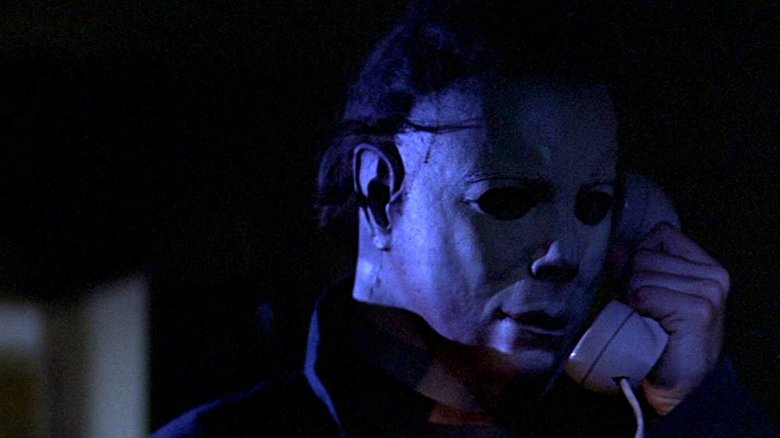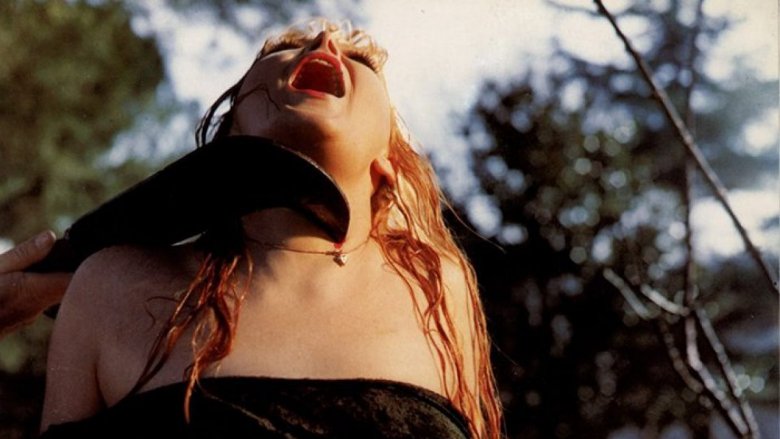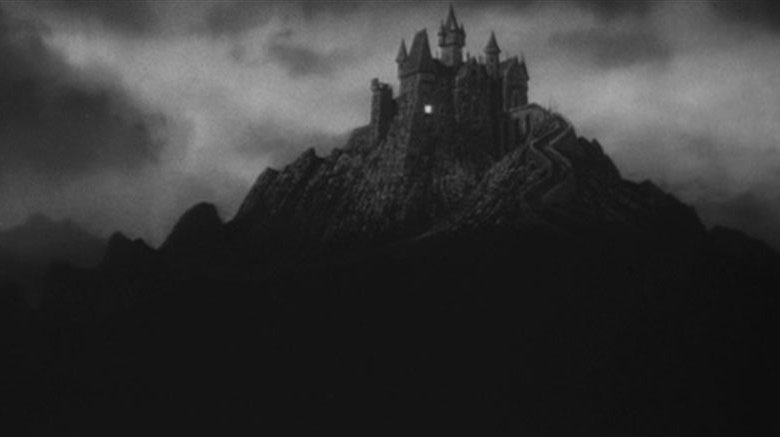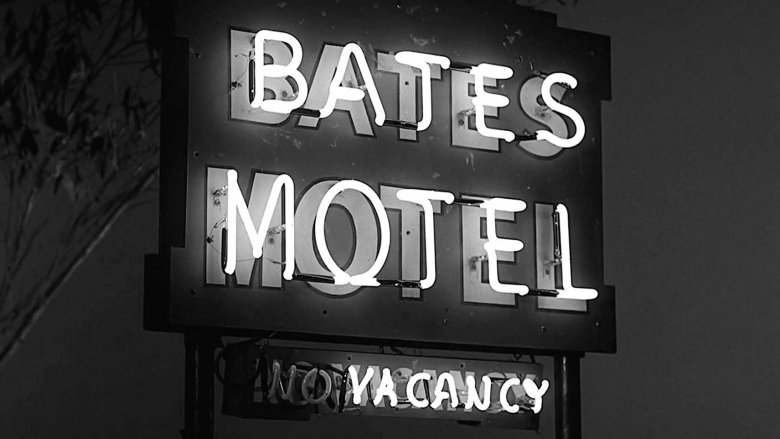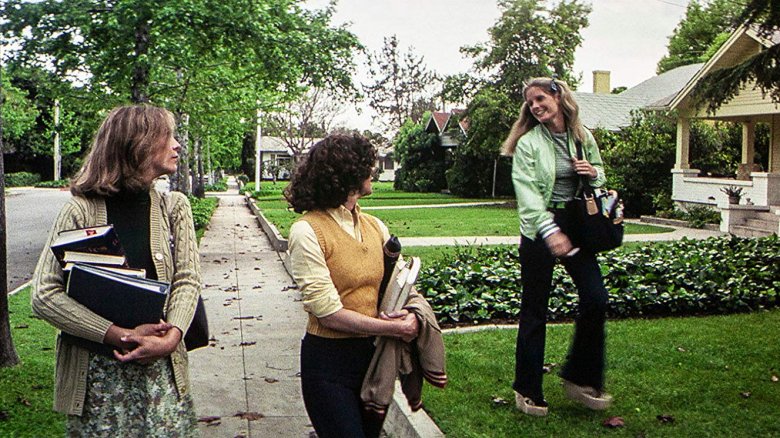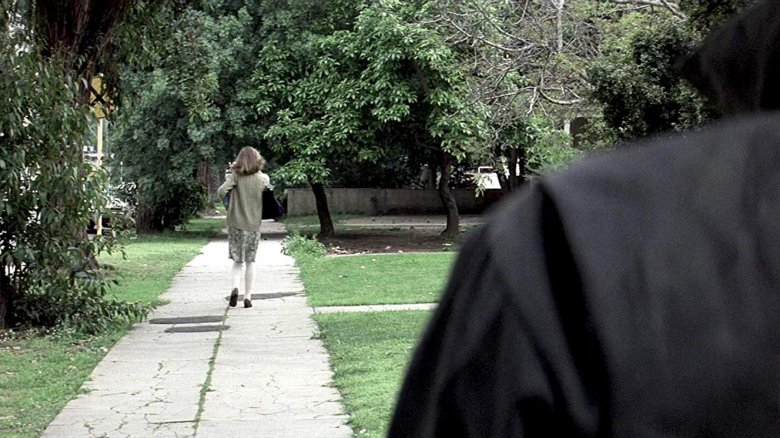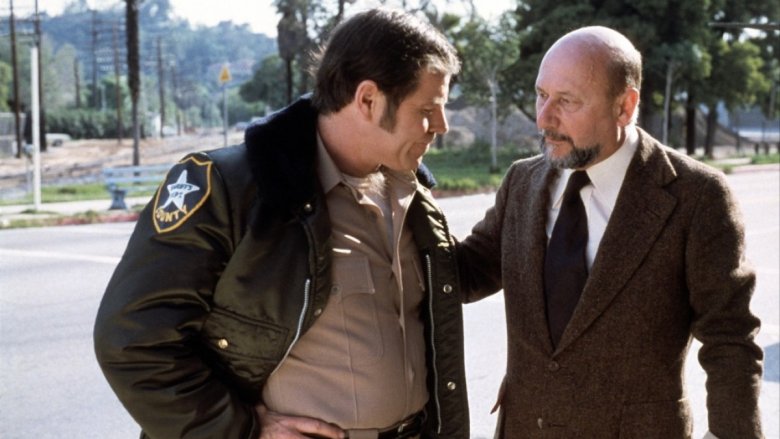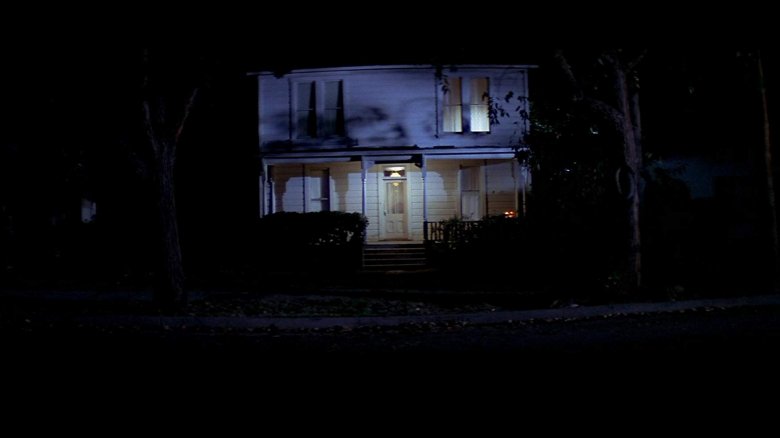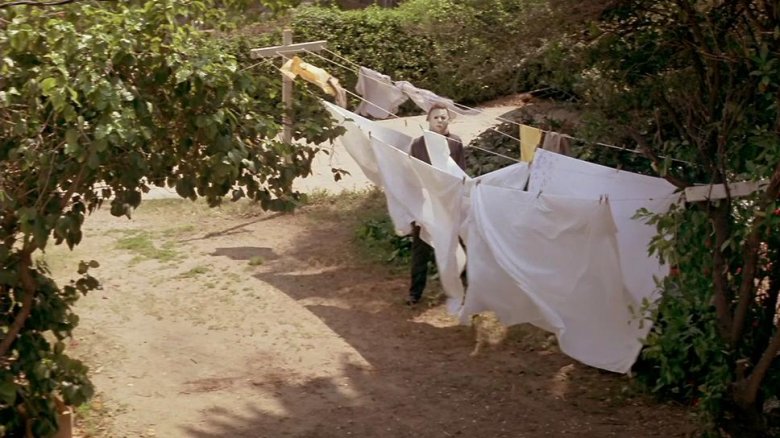The Scariest Thing In 1978's Halloween Isn't Michael Myers
John Carpenter's 1978 film Halloween is one of the most important and beloved horror movies ever made. From a critical standpoint, the original film is consistently ranked in the upper echelons of the genre's offerings. From an audience standpoint, the movie has been popular enough to spawn a franchise featuring seven sequels, a remake that itself got a sequel, and 2018's 40th anniversary sequel/franchise refresh that garnered critical acclaim and lots and lots of money.
What makes it so successful? Well, there's the tight script by Carpenter and co-writer Debra Hill. There are the strong performances by a young Jamie Lee Curtis and veteran Donald Pleasence. There's Carpenter's iconic score, one of the best known in the history of horror. There are the long, lingering, tension-building takes. And of course there's Michael Myers, the one constant through all sequels and iterations of the franchise (except Halloween III, of course). He's the draw of the series, the character that drives Halloween costumes and T-shirts and action figures. If you ask anyone what the scariest part of Halloween is, they'll likely tell you it's Michael Myers, the Shape, wandering through town with his knife, killing at random and leaving bodies in his wake.
But if you really think about it, Michael Myers is just a character on the screen. He can't really hurt you. What is it, then, about Halloween that should make you shudder and keep you up at night?
The importance of being Michael Myers
Michael Myers is arguably one of the greatest figures in the history of horror cinema and absolutely one of the most influential. The host of slasher killers that have followed in his wake are either directly inspired by him — like Jason Voorhees and Victor Crowley — or created in reaction to him, like Freddy Krueger or Chucky. The slasher subgenre dominated horror in the '80s, and a large part of that trend was the influence of Halloween in general and Michael Myers specifically.
What makes Myers so great? Well, obviously part of it is the look: the hulking figure with the impassive face (though his imposing size seems to increase as more sequels and remakes are released, peaking with the enormous Tyler Mane in Rob Zombie's two films), a shock of white in the darkness. But what's more is what lies in the name he's given in the credits of the film: the Shape. Michael is barely meant to be a human character; rather, he is a lurching, inexorable vessel for evil who can never be stopped. He's not a man, he's just a container for senseless and random violence. That inscrutability, the inability of even a trained doctor like Myers' childhood psychologist Dr. Loomis to be able to reach the Michael under the mask — and worse, the inability to stop him with a barrage of bullets to the chest — is a big part of what makes Michael Myers so memorably terrifying.
But he's not the scariest thing in Halloween. Not quite.
Everybody wants to be like Mike
Halloween is generally regarded as the movie that kicked off the slasher fad that dominated horror cinema from the late 1970s to the mid-1980s, but it's pretty rare that a genre just emerges ex nihilo. There are plenty of forerunners to Halloween's success that some horror fans would point to as earlier examples of the slasher genre. The most obvious example would be 1974's Black Christmas, which features young women being killed in a place previously assumed safe for them on an iconic holiday. Of course, the slasher genre would come to be more about the killer than their victims, and in Black Christmas the killer is never even seen (spoiler for a four-decade-old film, sorry). 1974's Texas Chain Saw Massacre showcases Leatherface, an iconic, hulking, masked killer like Myers, but the film features teenagers venturing outside their comfort zones into an unknown world to be killed.
Even earlier, the Italian giallo genre brought the world murder mystery films featuring masked killers in urban settings. Mario Bava's A Bay of Blood from 1971 (also known by the infinitely better title Twitch of the Death Nerve), with its unusual murders and setting by a lake is, for example, generally considered a proto-slasher. But these are crime films more than straightforward horror, and the victims are usually adults.
It was Halloween that brought together all the elements you now expect from a slasher: a superhuman masked killer, creative and even amusing murders, gory violence, teenage protagonists, and — most importantly in terms of distinguishing this new genre from older horror — a suburban setting.
Horror's gothic roots
To understand how movies like Halloween helped contemporize modern horror by moving the setting to the suburbs, you have to look at what horror looked like before the 1970s. Picture a black and white horror movie you've seen. Maybe it's Dracula or maybe it's Frankenstein, or maybe you're extra fancy and you're picturing 1944's The Uninvited or even 1963's The Haunting. Whatever it is, those movies are part of the gothic tradition that completely dominated horror movies for its earliest decades.
The gothic tradition goes back to 1764's The Castle of Otranto by Horace Walpole, and as Pat Gill lays out in "The Monstrous Years: Teens, Slasher Films, and the Family," the defining characteristics include "defenseless heroines; suppressed passions; unspeakable desires; fearful landscapes and haunted, uncanny interiors ... and jarring juxtapositions of the moral and the monstrous, the sexual and the grotesque, the virtuous and the violent." While it's really easy to draw a direct line from these elements to the slasher film, this description definitely fits those old black and white Universal films and their crumbly, cobwebby castles or foggy moors and, especially once you get to the late 1950s and the garishly colored Hammer era of gothic horror, the daringly plunging decolletage of the innocent victims.
The period settings and Mansard roofs that housed the genteel vampires and gossamer ghosts of classic horror weren't going to cut it in a post-Exorcist world, though. Horror was looking forward, just as America was.
The ubiquity of the Old Dark House
Perhaps the most important of all the distinguishing characteristics of the gothic genre is the setting. It is, after all, named after an architectural style (kind of). The first recognized work of gothic literature has "castle" in the title! The castle is the thing, or at least a spooky old house. Think of "The Fall of the House of Usher" or even The Haunting of Hill House, the latter of which proves that the setting doesn't have to be centuries ago as long as the house has enough history.
The idea that a house or a castle stretches back beyond the memory of its current tenants and holds secrets — dark secrets — was such a key trope in the development of horror that the Old Dark House became more than a trope and emerged as its own subgenre, as seen in movies like 1926's The Bat, in which a masked killer picks off guests in an isolated mansion one by one, and 1927's The Cat and the Canary, in which a crazed killer called "the Cat" escapes a mental hospital and hides in a creaky old mansion where the family who just inherited it are staying. Needless to say, 1932's The Old Dark House (one of the most underrated horror movies ever) is an example of the Old Dark House subgenre.
But if the horror of these films is based on the secrets held by the house's ancient history, how can you make a movie scary when it's set in a house that was just built?
How Psycho bridges the fantastic and the mundane
One of the key links between a movie like The Bat and Halloween is 1960's Psycho, which, not incidentally, is also a movie that deals heavily with modernization in its own way. While Hitchcock's film is undeniably one of the most influential horror films of all time — spawning a host of imitators such as 1963's Maniac and 1961's Homicidal – Halloween wears its connections to Psycho on its sleeve. Besides the fact that Halloween stars Jamie Lee Curtis, the daughter of Janet Leigh, whose character Marion Crane famously got stabbed in the shower (spoilers for a five-decade-old movie, sorry), one of the main characters — Dr. Samuel Loomis — is named after a character from Psycho. (Halloween also has a Marion in it, which is probably not a coincidence.)
Anyway, Psycho takes events that would earlier have been set in a castle or mansion and moves them to a much more modern setting: a motel. As Film School Rejects points out, the Bates Motel is itself the victim of modernization. It has been more or less abandoned due to the development of the interstate highway system, which isolates the motel and allows Norman to do his thing away from prying eyes. The contrast between the seemingly mundane setting for Norman's murders and horror's gothic history is made evident by the juxtaposition of the motel itself and the Bates home. Look, up on the hill: It's a giant spooky mansion, a reminder of our past. But like Norman's mother, it's dead. The killer is Norman now. The horror is the motel now, not the house.
Rocking the suburbs
As Film School Rejects explains, the 1970s saw horror move to the suburbs in a big way. This should have posed a problem for the haunted house movie because if a haunting relies on the ancient secrets held within the walls of a decaying old mansion, how can you have one when a house is brand new? Simple. As in The Exorcist and Poltergeist – and later the Paranormal Activity series — you have the ghost haunt a person, not a place.
Halloween dealt with this issue in a different way, by simply having Michael come home. The idyllic suburban environment of Haddonfield is where Michael was raised and where he did his first murder. Yes, in Haddonfield there are rumors and legends about the Myers home as a haunted house, but it's not a dilapidated estate along the lines of the Castle of Otranto. It's only been empty some 20 years, only enough for kids and teens to think of as "old." Michael lived on a street possibly much like yours — not a stately but deteriorating Victorian mansion, not some Eastern European castle, not a misty English moor — and now he was coming home.
Movies like The Exorcist and Halloween shifting their settings from remote, fantastical locations to the here and now of the modern suburban existence with its manicured lawns and white picket fences helped make horror relevant — and the fear more immediate — to modern audiences. To understand this, you have to understand the history of suburbs and why they became a thing in the first place.
White flight, white fright
As Britannica explains, thanks to the economic boom in the U.S. following World War II, an increasing number of Americans found themselves with the financial means to move away from the congestion of the city to lower-density residential areas outside the city. They could now afford single-family homes due to increased manufacturing and generous federal loan programs and, thanks to the interstate highway system that brought the Bates Motel to ruin and the increase in private car ownership, they could maintain a connection to the city by commuting to work. The process by which a city rapidly expands its geographical footprint is called urban sprawl, and the migration to these lower-density population centers is suburbanization.
While some Americans found themselves moving to the suburbs in order to accommodate rising populations within the city centers, a very large number of (affluent, white) Americans moved to the suburbs for different reasons. They might have said it was to be closer to nature, or to have room to stretch your legs, or because suburban land was cheaper than urban real estate, but the fact is, white Americans fled the city because they were afraid of – as Pat Gill puts it – "widespread crime, easy access to drugs, unsupervised friendships." White Americans were afraid of the city (and more precisely, the influx of a minority population there), so they grabbed up their children and ran away from it to protect them. This process is called "white flight," and it's the unspoken background radiation of Halloween.
'Lined up for a slaughterhouse'
At one point in the film, Dr. Loomis is warning the town sheriff of the dangers Michael presents, and the sheriff says incredulously, "You want to know what Haddonfield is? Children. Families, all lined up in rows up and down these streets. You're telling me they're lined up for a slaughterhouse." To which Loomis replies ominously, "They could be."
And this is the imagery upon which Halloween is based. While the suburbs were meant to be a place of safety and leisure for (white) families, full of dads with lawnmowers and football on the TV and so on, in fact they were simply the perfect staging ground for Michael's unique brand of trick or treating. (This is even more highly emphasized in 2018's Halloween, in which Michael literally strolls from house to house, causing mayhem like a kid, just deadlier.) Moving out to the suburbs didn't do anything to protect the victims of Michael Myers that night, and in fact they arguably would have been safer in a city, where a greater number of people might have been around to hear what was happening, call for help, or even intervene. Intervention would have gone badly, of course, but the point stands. The protection supposedly afforded by moving away from the alleged squalor and crime of the city actually ended up backfiring on the families who lost their children during Michael's return home. And worse, the negligence of parents who assumed their children were okay plays a considerable role in what happens.
It's 1978. Do you know where your parents are?
Hey, speaking of parents: Where are all the parents in this movie? There are practically no adults in this film at all. Dr. Loomis is there, plus a sheriff, and Laurie's dad for like a hot second as he passes off some of his responsibilities to her and then drives away. That's about it. Where are the parents of all these children Laurie and her friends are babysitting? Nowhere to be seen.
This isn't an accident. As the Cinephile Digest points out, an entire generation of teenagers felt abandoned by their parents and other authorities in the late 1970s. Coming out of the Vietnam War, this would have been a generation who would have felt betrayed by their parents, their communities, and most of all their government, who turned them into cannon fodder in a war they had never had any interest in. Like Myers, the war had been an uncontrollable source of violence that young people were left to by absent, apathetic adults. After all, they had moved them out to the suburbs where it was safe; what more did they need to do?
One of the most chilling images in the film comes when Laurie runs down the street banging on doors for help and no one will answer or even acknowledge her. This scene is ultimately reflective of the selfishness implicit in white flight: If me and mine are safe out here, who cares what happens elsewhere? In life, as in this film, that attitude never works out well for the younger generations.
The scariest thing
Thanks to Halloween, suburbia and other sites of suburban leisure such as camps are so ingrained in the slasher subgenre that it's worth mentioning when, for example, Jason goes to Manhattan. And that's because suburbia is intrinsic to the meaning of the film. As Pat Gill says, slasher films "seem to mock white flight to gated communities, in particular the attempts of parents to shield their children from the dangerous influences represented by the city."
Michael Myers and his knife aren't what you're supposed to be afraid of in Halloween, but rather what he represents: the idea that leaving the city behind and segregating yourselves from the minorities and immigrants you're afraid of isn't enough to protect your children. You have to take an active role, you have to care. Danger could come from anywhere, not just the city. The danger to the teenagers of Haddonfield wasn't a black man from the city, it was a guy — in fact, the whitest guy of them all, thanks to his mask — who grew up on that very block.
Danger is all around, and you can't just run away from it or bury your head in the sand. It could be anything or look like anyone. Evil is not a person, it's a Shape. You have to actively engage with your family and community to protect them, and even that might not be enough. And for some people, that's scary to think about.
